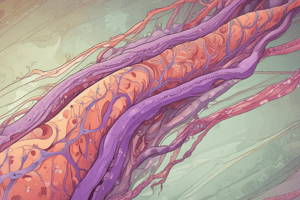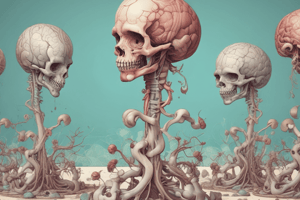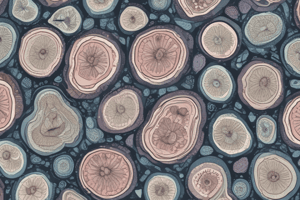Podcast
Questions and Answers
What type of secretory portion do sweat glands possess?
What type of secretory portion do sweat glands possess?
- Alveolar
- Coiled (correct)
- Simple tubular
- Acinar
What major component constitutes the extracellular matrix (ECM) in connective tissue?
What major component constitutes the extracellular matrix (ECM) in connective tissue?
- Adipose tissue
- Protein fibers (correct)
- Nerve cells
- Muscle fibers
Which of the following best describes mesenchymal cells?
Which of the following best describes mesenchymal cells?
- Undifferentiated spindle-shaped cells (correct)
- Mature adipocytes
- Epithelial cells with tight junctions
- Cuboidal gland cells
Which type of gland has a rounded, sac-like secretory portion?
Which type of gland has a rounded, sac-like secretory portion?
What tissue type primarily gives rise to connective tissue?
What tissue type primarily gives rise to connective tissue?
What is the primary function of the stratum corneum?
What is the primary function of the stratum corneum?
Which layer consists exclusively of keratin with no nuclei or organelles?
Which layer consists exclusively of keratin with no nuclei or organelles?
What does internal remodeling of bone involve?
What does internal remodeling of bone involve?
Which statement accurately describes the stratum germinativum?
Which statement accurately describes the stratum germinativum?
What does external remodeling of bone primarily address?
What does external remodeling of bone primarily address?
What characterizes rough endoplasmic reticulum (RER)?
What characterizes rough endoplasmic reticulum (RER)?
Which structure primarily functions in post-translational modification of proteins?
Which structure primarily functions in post-translational modification of proteins?
What is primarily found in heterochromatin?
What is primarily found in heterochromatin?
What is a key feature of smooth endoplasmic reticulum (SER)?
What is a key feature of smooth endoplasmic reticulum (SER)?
Which tissue type primarily serves a supporting role within organs?
Which tissue type primarily serves a supporting role within organs?
Which embryonic germ layer gives rise to the nervous system?
Which embryonic germ layer gives rise to the nervous system?
What is the function of lysosomes in the context of the Golgi apparatus?
What is the function of lysosomes in the context of the Golgi apparatus?
The term 'basophilic' is often used to describe which cellular component?
The term 'basophilic' is often used to describe which cellular component?
What primarily binds the periosteum to the bone?
What primarily binds the periosteum to the bone?
Which type of bone is also known as trabecular or spongy bone?
Which type of bone is also known as trabecular or spongy bone?
Where are osteoprogenitor cells primarily found?
Where are osteoprogenitor cells primarily found?
What serves as a sparse network of collagen with osteoblasts and bone lining cells?
What serves as a sparse network of collagen with osteoblasts and bone lining cells?
What type of bone contains a dense packing of osteons?
What type of bone contains a dense packing of osteons?
What cellular components are found in the inner layer of the periosteum?
What cellular components are found in the inner layer of the periosteum?
Which of the following is NOT a feature of cancellous bone?
Which of the following is NOT a feature of cancellous bone?
What is primarily found in the outer region of bones?
What is primarily found in the outer region of bones?
Which statement about osteoprogenitor cells is correct?
Which statement about osteoprogenitor cells is correct?
What is the primary characteristic of immature bone?
What is the primary characteristic of immature bone?
What is the primary function of Meissner corpuscles?
What is the primary function of Meissner corpuscles?
Which phase of the hair growth cycle is characterized by mitotic activity?
Which phase of the hair growth cycle is characterized by mitotic activity?
What type of gland is associated with the hair follicle and undergoes holocrine secretion?
What type of gland is associated with the hair follicle and undergoes holocrine secretion?
What is the role of the dermal papilla in hair structure?
What is the role of the dermal papilla in hair structure?
Where are Pacinian corpuscles primarily located?
Where are Pacinian corpuscles primarily located?
What structure is known as the hard plate of keratin on the distal phalanx?
What structure is known as the hard plate of keratin on the distal phalanx?
Which type of sweat gland is primarily found in the axillary and perineal regions?
Which type of sweat gland is primarily found in the axillary and perineal regions?
What type of receptor is exclusively located in the epidermis and is unencapsulated?
What type of receptor is exclusively located in the epidermis and is unencapsulated?
What is the primary component of sebum produced by sebaceous glands?
What is the primary component of sebum produced by sebaceous glands?
Which part of the nail is covered by skin and located proximally?
Which part of the nail is covered by skin and located proximally?
What is the main function of Krause end bulbs?
What is the main function of Krause end bulbs?
What is the general role of the arrector pili muscle in hair follicles?
What is the general role of the arrector pili muscle in hair follicles?
In which layer of the hair follicle is the internal root sheath found?
In which layer of the hair follicle is the internal root sheath found?
Which type of touch do Ruffini corpuscles primarily sense?
Which type of touch do Ruffini corpuscles primarily sense?
Study Notes
Cellular Organization and Embryology
- Tissues: cells with similar or closely related functions grouped together to form larger structures and functional units (e.g., organs).
- Basic tissue types: epithelial, connective, muscle, nervous
- Organs: composed of two tissue types.
- Parenchyma: responsible for specialized functions.
- Stroma: supporting role, usually connective tissue.
- Embryonic germ layers:
- Ectoderm: divided into surface ectoderm (e.g., epithelium, anterior pituitary) and neural tube.
Connective Tissue
- Supports & connects other tissues and cells.
- Extracellular matrix (ECM): major constituent.
- Protein fibers: e.g., collagen, elastic fibers.
- Ground substance:
- Origin from mesenchyme:
- Mesodermal tissue consisting of viscous ground substance with few collagen fibers.
- Mesenchymal cells: undifferentiated, spindle-shaped cells with large nuclei and prominent nucleoli. Migrate from site of origin to developing organs.
Connective Tissue Cells
- Fibroblasts
- Most abundant resident cells.
- Synthesize and secrete ECM components (e.g., collagen, elastin, proteoglycans).
- Macrophages
- Phagocytize cellular debris, bacteria, and other foreign particles.
- Present antigens to lymphocytes.
- Mast cells
- Release histamine and other inflammatory mediators.
- Involved in allergic reactions and wound healing.
- Plasma cells
- Derived from B lymphocytes.
- Secrete antibodies.
- Adipocytes
- Store fat.
- Play a role in energy metabolism and insulation.
- Leukocytes
- White blood cells that migrate from the bloodstream into connective tissue.
- Involved in immune responses.
Bone
- Periosteum and endosteum: connective tissue lining external (periosteum) and internal (endosteum) surfaces of bones.
- Periosteum:
- Fibrous layer of dense connective tissue.
- Contains type I collagen, fibroblasts, and blood vessels.
- Perforating (or Sharpey) fibers: periosteal collagen fibers that penetrate the matrix and bind the periosteum to bone.
- Inner periosteum is more cellular with osteoblasts and bone limiting cells.
- Osteoprogenitor cells: mesenchymal stem cells also seen in endosteum. Proliferate extensively and produce many new osteoblasts.
- Endosteum:
- Very thin layer that covers the trabeculae (bone matrix that projects into the marrow cavities).
- Sparse network of collagen with osteoprogenitor cells, osteoblasts, and bone lining cells.
- Osteoprogenitor cells à osteoblasts.
- Perichondrial fibroblast-like progenitor cells à chondroblasts.
- Periosteum:
Types of Bone
- Immature/Woven Bone:
- Also called immature, woven, or primary bone.
- Newly calcified.
- Composed of irregularly arranged collagen fibers.
- Found in fetal bone, fracture callus, and some pathological conditions.
- Lamellar Bone:
- Mature bone.
- Composed of thin lamellae (layers) of bone matrix with collagen fibers arranged in parallel.
- Gives bone its strength and resilience.
- Two sub-types.
- Compact bone:
- Also called cortical bone.
- Densely packed osteons or parallel lamellae.
- Outer region of bones, adjacent to periosteum.
- Cancellous bone:
- Also called trabecular, spongy, or medullary bone.
- Interconnected thin spicules or trabeculae covered by endosteum.
- Inner region of bones, adjacent to marrow cavity.
- Compact bone:
Bone Cells
- Osteoblasts: Synthesize and secrete bone matrix.
- Osteocytes: Mature bone cells embedded in bone matrix. Maintain bone matrix. Communicate with each other and osteoblasts via canaliculi.
- Osteoclasts: Large multinucleated cells that resorb bone matrix.
- Bone lining cells: Flattened cells that cover bone surfaces.
Bone Remodeling and Repair
- Bone remodeling: Allows bone to remain plastic and adaptable.
- Internal remodeling: Coordinated activities for bone resorption and formation.
- External remodeling: Changes in bone shape due to external factors (e.g., weight-bearing).
- Bone repair:
- Injury leads to a cascade of events, including inflammation, formation of a fracture hematoma, and repair of bone tissue.
- Callus formation: A temporary structure of woven bone and cartilage that forms at the fracture site.
- Remodeling: Gradual replacement of the callus with lamellar bone.
- Growth Plate: Hyaline cartilage between the epiphysis and diaphysis in growing bones.
Cartilage
- Special connective tissue: Provides support, flexibility, and resilience.
- Avascular: Lacks blood vessels, nutrients are supplied by diffusion.
- Cells:
- Chondroblasts: Immature cartilage cells; synthesize and secrete cartilage matrix.
- Chondrocytes: Mature cartilage cells embedded in cartilage matrix. Maintain cartilage matrix.
- Types of cartilage:
- Hyaline cartilage: Most common; Found in articular surfaces of joints, ribs, nose, trachea.
- Elastic cartilage: Found in ears, epiglottis, and certain parts of the larynx.
- Fibrocartilage: Found in intervertebral discs, menisci, and pubic symphysis.
Skin
- Largest organ in the body.
- Functions: Protection, temperature regulation, sensory perception, excretion.
- Layers:
- Epidermis: Outermost layer; Epithelial tissue; stratified squamous keratinized.
- Dermis: Layer beneath the epidermis; Connective tissue; Contains blood vessels, nerves, hair follicles, and glands.
- Hypodermis: Subcutaneous layer; Loose connective tissue; Contains fat cells, blood vessels, and nerves.
Epidermis Layers
- Stratum basale (Germinativum): Deepest layer; Single layer of cuboidal cells; Cell division occurs here.
- Stratum spinosum: Several layers of polyhedral cells; Cells are connected by desmosomes.
- Stratum granulosum: Few layers of flattened cells; Contains keratohyalin granules, which contribute to keratinization.
- Stratum lucidum: Thin, clear layer; Present only in thick skin (palms and soles).
- Stratum corneum: Outermost layer; Several layers of dead, flattened cells; Contains keratin.
Skin Cells
- Keratinocytes: Predominant cells; Produce keratin, a protein that gives skin its toughness.
- Melanocytes: Produce melanin, a pigment that contributes to skin color and protects against UV radiation.
- Langerhans cells: Antigen-presenting cells; Involved in immune responses.
- Merkel cells: Mechanoreceptors; Respond to light touch.
Skin Appendages
- Hair: Elongated, keratinized structures present in all skin except the palms, soles, lips, glans penis, clitoris, and labia minora.
- Hair shaft: Part of the hair extending beyond the skin surface.
- Hair root: Part of the hair embedded in skin.
- Hair follicles: Epdermal invaginations where hair forms.
- Hair bulb: Terminal dilation of a growing hair follicle.
- Dermal papilla: Inserts into the base of the hair bulb. Carries capillaries and is lined with basal keratinocytes.
- Arrector pili muscle: Smooth muscle connecting hair sheath to papillary dermis. Contraction pulls the hair shaft erect.
- Nails: Hard plates of keratin on the dorsal distal phalanx.
- Nail plate: Hard plate of keratinized cells.
- Nail bed: Epidermis under the nail plate. Contains only basal and spinous layers.
- Nail root: Proximal part of the nail covered by skin.
- Nail matrix: Area of proliferating, differentiating keratinocytes in the root. Responsible for nail growth.
- Eponychium: Dorsal extension of the epidermal stratum cornea from the nail root.
- Hyponychium: Distal end of the plate free of the nail bed.
- Sebaceous glands: Embedded in the dermis.
- Pilosebaceous unit: Hair follicle plus associated gland.
- Branched acinar glands: Empties into the upper portion of a hair follicle in hairy skin, or directly onto the epidermal surface in hairless skin.
- Holocrine secretion: Basal cells proliferate and differentiate into sebocytes. Cells undergo autophagy and release lipids.
- Sweat glands: Develop as epidermal invaginations embedded in the dermis.
- Eccrine sweat glands: Widely distributed; Most numerous on soles.
- Apocrine sweat glands: Confined to the axillary and perineal skin. Development depends on sex hormones.
Sensory Receptors
- Meissner's corpuscle: Found in fingertips, palms, and soles. Light touch and low-frequency vibrations.
- Pacinian corpuscle: Found in reticular dermis, hypodermis, and walls of rectum, urinary bladder, etc. Responds to coarse touch, pressure, and high-frequency vibration.
- Merkel cell: Only unencapsulated receptor. Located in epidermis. Responds to light touch and pressure.
- Krause end bulbs: Found in the dermis of the penis and clitoris. Respond to low-frequency vibrations.
- Ruffini corpuscle: Found in the reticular dermis. Responds to stretch and twisting of the skin.
Studying That Suits You
Use AI to generate personalized quizzes and flashcards to suit your learning preferences.
Related Documents
Description
Test your knowledge on cellular organization, tissue types, and embryonic development with this comprehensive quiz. Explore concepts like connective tissue, organ composition, and germ layers. Perfect for students studying biology or related fields.





